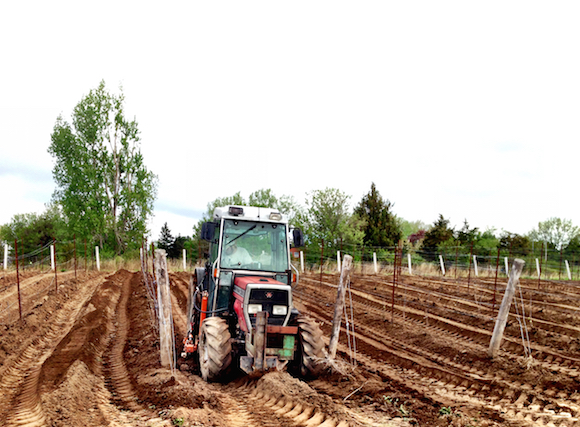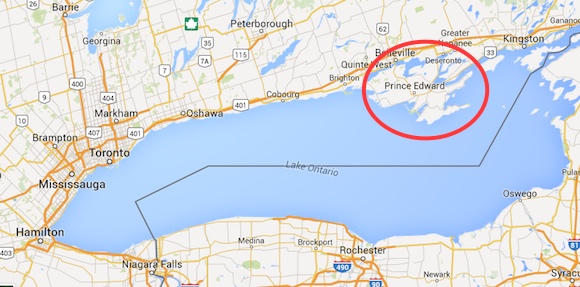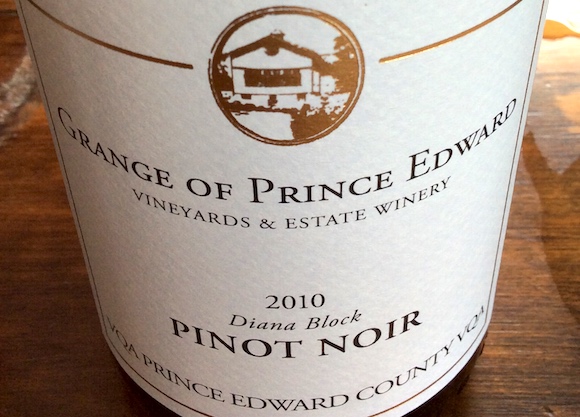I’m still sifting through the voluminous results of last week’s All Canadian Wine Championships, in which BC fared very well. The competition is held in Prince Edward County (about 275 kms. northeast of Niagara), widely regarded as one of North America’s most up and coming regions. More on that, coming in detail, as soon as I can get to it …
Before the judging, I had an opportunity to spend a day touring around a few Prince Edward County wineries, at what happened to be a critical time in the vineyard. Most were in the process or just finishing de-hilling.
In Prince Edward County, as in many borderline regions, winter mounding is employed to protect the vines from potentially lethal temperatures that can dip to minus thirty Celsius. Yet, while “hilling up” is critical to the vines’ survival, equally as crucial is deciding on the right time for de-hilling.
Even though Prince Edward County is on Lake Ontario’s north shore, which brings moderate temperatures year round and shelters the region from early fall frosts, winter temperatures still fall dangerously low, to the point where most varieties will die.
“Hilling up” provides the necessary extra protection. But calling the shots on de-hilling can be tricky: go too early and you run the risk of exposing the juvenile buds to spring frosts—especially around a full moon. Wait too long and the growth will be stunted, denied crucial sunlight between bud break and bloom that’s vital for the fruit’s development.
Deliberately and very precisely, a tractor makes its way through the vineyard with a blade that neatly scrapes the soil off the mounds surrounding the vines.
It takes a firm hand a keen eye for successful de-hilling. If the blade is too far from the vine, more manual work will be needed. Too close, and you run the risk of knocking off tender buds or, worse, even severing the vine entirely.
Winter mounding may be laborious and costly. But it’s vital to this up and coming region’s survival.
Prince Edward County’s most produced varieties include: Pinot Gris, Riesling, Chardonnay, Baco Noir, Cabernet Franc, Gamay and Merlot. In these early days, wineries are still finding out what works best. A key player is the region’s geology. The soils are rich in limestone, once entirely covered by water. Most of the area’s 40 or so wineries are situated on ideal shallow topsoil or sandy loam over limestone bedrock, which can add a distinctly mineral flavour to many varieties. The outcrop is significant, so much so that even planting new vines can prove to be a real challenge.

The Agrarian Cheese Market & Speakeasy in Bloomfield—a good spot to discover local flavours on every level
Wine tourism on the rise
No shortage of activities centres on the picturesque communities of Bloomfield and Picton. A wide range of dining and accommodation offers plentiful choice, such as historic Waring House, which sports a cosy pub with live entertainment most nights, as well as luxurious suites in two newly constructed complexes. Just about mid-way between Toronto and Ottawa, (and not that far from Montreal) the “county” is being discovered as a closer alternative to Niagara by wine lovers in those cities.
Tasting Prince Edward County
Some highlights from our whirlwind tour included:
Keint-He Portage Chardonnay 2013 (PEC). Floral and citrus notes followed by a juicy lemon drop palate with definite, lingering mineral , zest and stone fruit. 91 pts.
Norman Hardie Pinot Noir 2013 (PEC). Bright, vibrant cherry notes opening up to complex layers of savoury and earthy hints. 91 pts.
Closson Chase Chardonnay 2013 (PEC) Stone fruit and flinty notes up front followed by tropical and orchard fruit with good acidity, well integrated oak with a touch of spice to close. 91 pts.
Grange of Prince Edward Diana Block Pinot Noir 2010 (PEC). Luscious fruit entry wrapped in juicy acidity, underpinned by earth and mineral notes, with a persistent close. 92 pts.
Click here for more and for touring info
(This material also appeared in the North Shore News)



Leave A Comment